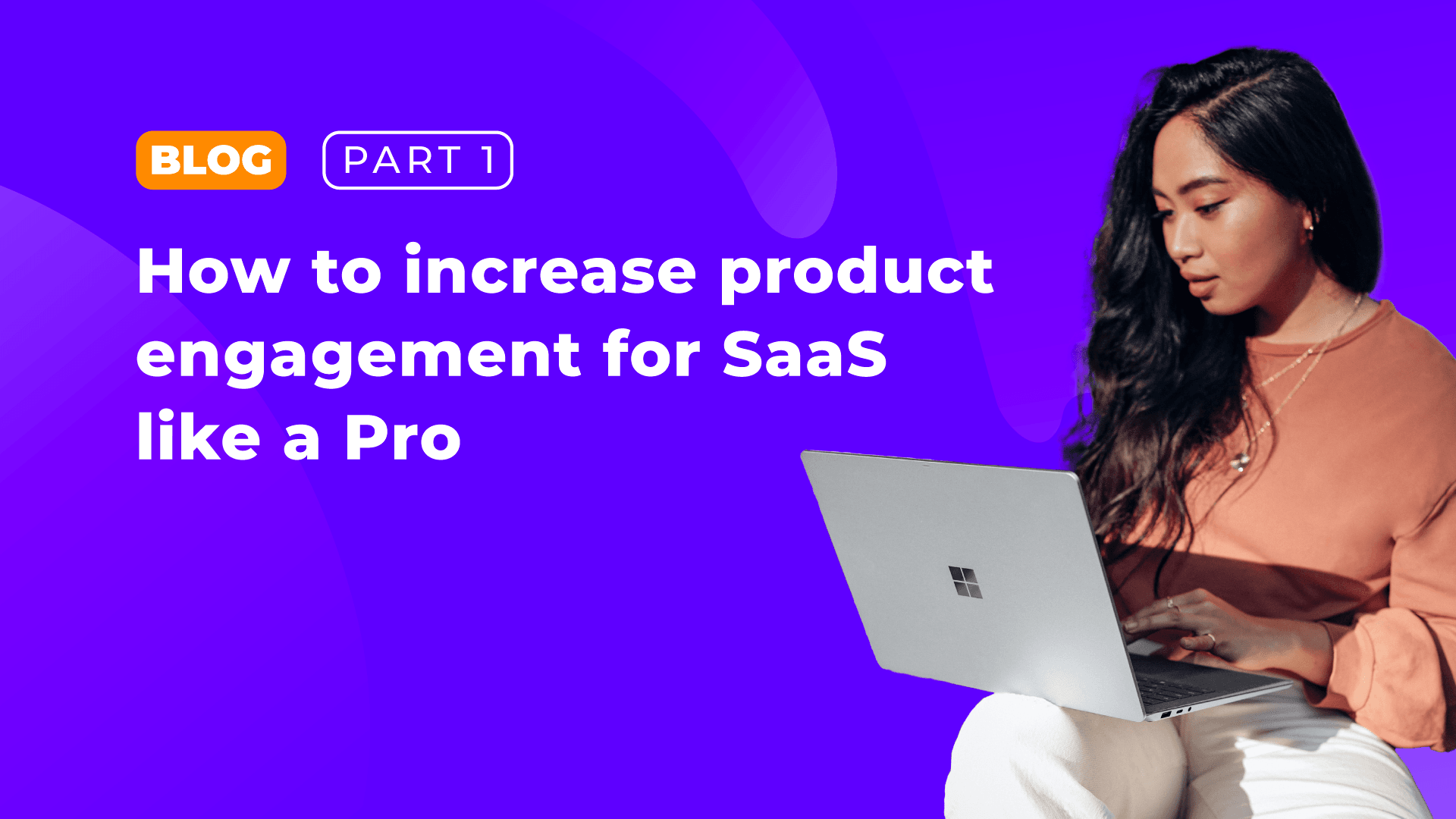7 mins read
[/fusion_content_box][/fusion_content_boxes]
[/fusion_builder_column][/fusion_builder_row][/fusion_builder_container]How to increase product engagement for SaaS like a Pro: Part 1

What is product engagement and how do you increase it? Product engagement is a lagging indicator that gives insight into how users interact with your product. It measures things like user or app engagement, retention, feature engagement & active users.
This is part 1 of a two-article series where we discuss how to increase product engagement. In this article, you’ll learn what product engagement is, how to measure it & what metrics are most important!
- What is product engagement?
- SaaS and the role of product engagement
- What makes a product engaging?
- Why is product engagement analysis important?
- How to measure product engagement like a Pro
- The key product engagement metrics you need to know
- How to increase product engagement for your SaaS platform
- FAQ
What is product engagement?
Product engagement is a way of measuring how users interact with your product. Usually, this happens on 3 axes: depth (app engagement & retention), breadth (feature adoption) & frequency (stickiness & active usage). Once you understand the leading indicators for this behavior you’ll know how to increase product engagement.
SaaS and the role of product engagement
Product engagement is an indispensable metric for SaaS companies. This 1 metric shows you everything you need to know about app engagement, retention & product adoption. Understanding this user behavior can help you build better roadmaps, shape more personalized experiences, and ultimately increase customer lifetime value!

The goal is not to have a bunch of unused features or churning customers. On the contrary, you want to drive user engagement to increase the number of interactions, get more data & build a more sticky experience based on that. Once you understand product health, you can test with gamified tactics to boost product growth!
What makes a product engaging?
Simply put, a great product will keep users coming back. A good user experience can increase conversion rates by 400%. When users are motivated to use your product it’s probably because you solve a key problem in a better way. That’s why user engagement usually has a big impact on user retention or churn.
To create a UX that fosters user engagement, you can leverage psychological triggers. Fulfilling basic human desires such as autonomy, value, and competence can drastically improve app engagement and retention. Additionally, a gamified approach can boost user motivation and make seemingly mundane tasks into an enjoyable experience!
Why is product engagement analysis important?
Great products don’t just build new features. Instead, they study user behavior and build features to support their users’ goals and needs. Analyzing product engagement can help you identify in what areas you could still improve app engagement.
With this data, you can answer questions such as:
- Do they use it frequently or not? How often?
- How much time are users spending on your platform?
- Are they utilizing the full product or just a few features?
- What are the most popular features?
- Do they keep coming back or do they churn?
Besides evaluating just the efficacy of your product and its features, you also need to analyze your users. Which users are about to churn? Who can you upsell to? Comprehensive analysis like this will inform your feature tweaks and can help boost motivation through gamified tactics.
How to measure product engagement like a Pro
Before you learn how to increase product engagement, you need to have the right tracking in place. So how do you measure product engagement?
First of all, there are many leading indicators going into your product engagement score. That’s why you’ll need to track all product interactions to measure things like user engagement, adoption & stickiness.
Here’s a 5 step plan to get you started right away!
Step 1: Set up product analytics
Success isn’t built on guesswork! Before you can even think about learning how to increase product engagement, you need a product analytics tool that can equip you with the best, most up-to-date data. This data will form the bedrock of your strategy.
Step 2: Identify the problem your product solves
To measure user engagement, it pays to know why your users engage in the first place. Knowing the problem that your product solves for users will highlight which tasks you can leverage, as well as those with the maximum impact on activation.
Step 3: How frequent is this problem?
Of course, if you want to increase efficiency, (gifting you more money to spend elsewhere), it makes sense to optimize the most common user pains. In practice, solving a user’s most persistent problems leads to organic and long-term user engagement.
Step 4: Create and test your hypothesis
Identifying the problem is one thing, but formulating solutions is harder. Eventually, you will need to draw a conclusion from the data mined from existing user engagement. Following that, your next step should involve developing and testing a hypothesis.
Generally, a hypothesis is a 3 step document:
- We believe that this new feature/tweak…
- Will result in this outcome…
- And its success will be defined by the occurrence of X measurable change.
For example: “we believe that a gamified challenge will result in a boost to user engagement, and success will be defined by a 5% rise in average session duration”.
Step 5: Measure the results!
So you’ve tested a new feature and received buckets of user engagement data in return. That’s great! But you need a way to make sense of the numbers. One of the preferred methods to measure differences in product engagement is through Cohort Analysis.
In brief, a Cohort Analysis chart organizes your data by date of user acquisition, allowing you to compare any tweaks and experiments by comparing their effect on new users compared to existing ‘cohorts’.

The key product engagement metrics
When talking about product & user engagement, these 5 metrics give you a general overview on how your product is performing. It shows you how engaging your product is, and also where there’s still room for improvement.
Finally, you can test with gamified tactics to increase user activation, engagement & retention! That said, here are 5 key product engagement metrics to look after:
Daily/Monthly Active Users (DAU/MAU rate)
Daily Active Users / Monthly Active Users = DAU/MAU Rate
Comparing your daily (DAU) and monthly active users (MAU) gives you an indication of how sticky your product is. For example, if you have 100 daily active users, and 1000 monthly active users, your DAU/MAU rate is 0.1. In other words, 1 in 10 monthly active users also engage on a daily basis.
Stickiness Ratio
DAU/MAU rate * 100 = %
Take the DAU/MAU Ratio one step further by formulating it as a percentage. The stickiness ratio also reveals how much repeated user engagement you generate. Currently, the median score for SaaS is 9.4%, which equals under 3 days of monthly engagement! Contrast that with the top performers in SaaS, who have a stickiness rate of 28.7%!

Our top tip for developing a sticky product? Easily build a gamified experience & increase active usage by +50%!
Average Session Duration
Duration of All Sessions / Number of Sessions = Average Session Duration
The average B2B SaaS boasts an Average Session Duration of 4 minutes and 26 seconds. In essence, that time encompasses the length of time from the user’s first click on your platform up till their last. This metric is one you definitely want to improve. Why? Because increasing Average Session Duration correlates directly with higher conversion rates!
Retention Rate
(Users at end of time period / Total number of paying customers at beginning of period) * 100 = %
The Retention Rate reveals how many loyal customers you have. One great way to track this data is with the Cohort Analysis chart we mentioned earlier. In short, retention is an important sign of good business health and customer satisfaction. For SaaS, lower Monthly Retention Rates start at 35%, compared to the highs of 93%.
Churn Rate
(Customers who left / Total number of customers) * 100 = %
Churn measures what percentage of customers leave your app within a set timeframe. In contrast to the Retention Rate, it shows how many users you lost over a week, month, or quarter,… Churn is a real dealbreaker in SaaS. Not only does it lead to lower revenue, but it also impacts the customer acquisition cost & customer lifetime value! It’s usually an effect of low app engagement or an unsatisfying experience.
How to increase product engagement for your SaaS platform
According to the data team of Sequoia Capital, the leading venture capital fund that has invested in companies like Apple, Zoom & Doordash just to name a few, user engagement is the fundamental growth driver. It’s what ultimately leads to stickiness, retention & growth.
There are many things you could do to boost engagement. Think of gamified onboarding, personalized notifications, rewards programs,… However, measuring product engagement is the first crucial step. Once you understand which product levers can increase user motivation, you’ll know how to increase product engagement. It’s just a matter of experimenting with the right tactics to boost your growth.
Keep reading the StriveCloud blog for Part II and discover 17 actionable strategies on how to increase product engagement in 2022.

